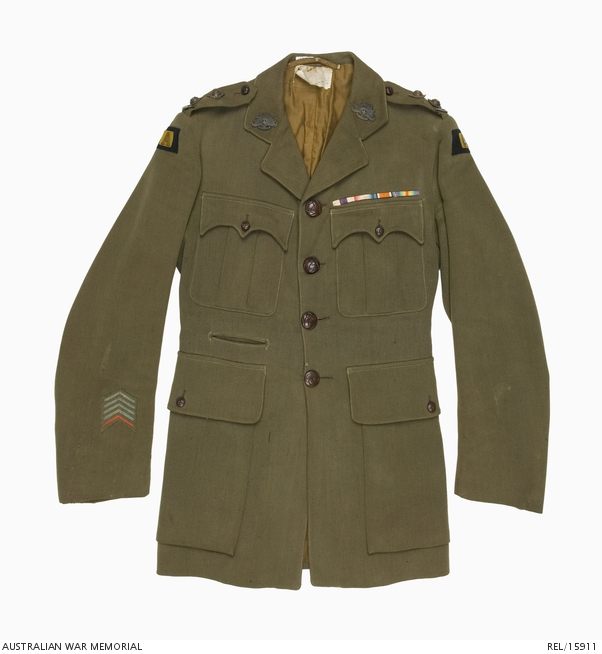| Place | Europe: United Kingdom |
|---|---|
| Accession Number | REL/15911 |
| Collection type | Heraldry |
| Object type | Uniform |
| Physical description | Cotton, Leather, Oxidised brass, Silk, Wool gabardine |
| Maker |
Unknown |
| Place made | United Kingdom |
| Date made | c 1918 |
| Conflict |
First World War, 1914-1918 |
Service dress tunic : Lieutenant A Honybun, 1 Machine Gun Battalion, AIF

Privately made khaki wool gabardine officer's tunic with notched collar carrying oxidised brass 'Rising Sun' collar badges, shoulder straps with oxidised brass 'AUSTRALIA' titles and rank pips for a lieutenant, pleated breast pockets with triple pointed flaps, expanding hip pockets with rectangular flaps, a small inset welt pocket at the right waist, a centre back vent and plain cuffs. The shoulder straps, pockets and front of the tunic close with pressed leather buttons. The head of each sleeve carries a black and yellow colour patch, with brass Anzac 'A', for 1 Machine Gun Battalion. The lower right sleeve carries five woven service chevrons, one red and four blue. Medal ribbons for the Military Cross, 1914-15 star, British War Medal 1914-20 and Victory Medal are sewn above the left breast pocket. The tunic is lined throughout.
Born in London in 1894, Anthony Garvis Honybun emigrated to Melbourne together with his parents and eleven siblings in 1910. He was employed as a motor mechanic when he enlisted in the AIF on 17 August 1914. He had previously been employed as a gardener by the Anglican Archbishop of Melbourne. After initial training Honybun was assigned as a private, service number 793, to G Company, 8th Battalion, AIF. The unit sailed for Egypt from Melbourne on 19 October aboard HMAT Benalla.
After further training in Egypt, Honybun and his battalion landed at Gallipoli on 25 April 1915 as part of the second wave. Ten days later the battalion transferred to Cape Helles to take part in the attack on Krithia. Later, the battalion fought in August at Lone Pine. Writing to his former employer, the archbishop, Honybun described the action as 'a hail of bullets and shellfire, a veritable hell on earth'. On 26 November he was promoted to lance corporal, shortly before being evacuated sick to Egypt on 3 December.
By the end of January 1916 Honybun had reached the rank of sergeant. At the beginning of March he transferred to the newly formed 2nd Machine Gun Company, with the rank of second lieutenant. The Company arrived in France at the end of March. In July it took part in the battle of Pozieres. At the beginning of December Honybun was evacuated sick to the 20th (British) General Hospital at Camiers. He was discharged a week later but remained at the machine gun base depot at Camiers until May 1917, when he rejoined his unit in the field.
During the Third Battle of Ypres Honybun was wounded at Polygon Wood, on 20 September 1917, when he sustained a gunshot wound to his right thigh. He was evacuated to the 3rd London General Hospital, rejoining his unit at the beginning of November, where he received the news that he had been awarded the Military Cross for his actions at Polygon Wood. The recommendation for the award stated 'The success of the operation was due in a great measyre to the sound knowledge displayed by this officer.'
In April 1918 the 2nd Machine Gun Company was merged with other MG companies to form the 1st Machine Gun Battalion. Honybun was posted to the Army Infantry School but contracted influenza in June. At the beginning of July he was diagnosed with debilty and was prescribed 'rest, tonic and change'. Three weeks later he returned the machine gun depot at Camiers. On 24 September he was placed on the supernumerary list. He saw no further active service and took extended leave in England. He returned to Australia aboard the troopship Borda in December 1919, accompanied by his wife, whom he had married in England at an unknown date.
This privately made tunic, worn with Sam Browne belt REL/21633, was made in the UK for Honybun towards the end of 1918. It has plain cuffs instead of the regulation pointed cuffs common to most officer's tunics.